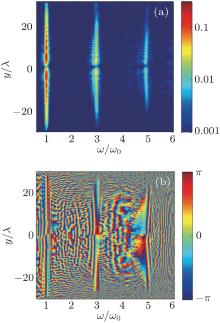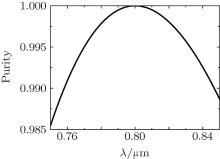†Corresponding author. E-mail: lmchen@iphy.ac.cn
*Project supported by the National Basic Research Program of China (Grant Nos. 2013CBA01501 and 2013CBA01504), the National Key Scientific Instrument and Equipment Development Project, China (Grant No. 2012YQ120047), CAS Key Program and National Natural Science Foundation of China (Grant Nos. 11135012 and 11375262), and a Project of Higher Educational Science and Technology Program of Shandong Province, China (Grant No. J11LA52).
Harmonics generated by an intense femtosecond Gaussian laser pulse normally incident on a spiral-shaped thin foil target were studied. By using two-dimensional (2D) particle-in-cell (PIC) simulation, we observed evident odd harmonics signals in the reflection direction and found that the reflected field has a helical structure determined by the target shape. This method provides a new way to generate an intense ultraviolet vortex with high-order topological charge by use of ultrahigh intense laser-driven harmonics.
A typical singular beam optical vortex[1– 3] has a well-defined orbital angular momentum (OAM) of mħ per photon for its helical wave front, which can be expressed as f (r)exp(imφ ), where (r, φ ) are the polar coordinates. The topological charge (TC) m is usually an integer. The optical vortex can be applied in the fields of quantum information processing, [4, 5] trapping atoms or mesoscopic particles, [6– 9] material processing, [10, 11] etc. Recently, the optical vortex has been applied in strong field physics, high-energy photon generation with large OAM by high harmonic generation[12– 14] and Compton backscattering, [15– 17] laser driven donut wake fields for positron and electron acceleration, [18, 19] laser driven wake fields for proton acceleration, [20] direct acceleration of electrons in a vacuum, [21] etc. For production of an ultrahigh intense optical vortex, Shi et al.[22] proposed the use of a relativistic laser pulse with a high photon density interacting with a spiral-shaped thin foil target, creating a twisted relativistic light pulse to the reflected light. So far, the reflected light in such a situation has not been studied in much detail.
In this paper, we studied the reflected light from the relativistic Gaussian laser pulse normally incident on a thin solid target with a helical structure. We have found that the reflected light has the helical structure caused by the target and possesses evident high-order odd harmonics with high-order TC.
Figure 1(a) shows the three-dimensional (3D) structure of the spiral-shaped thin foil target, whose thickness is a linear function of the azimuth:

where (ρ , φ ) are the polar coordinates on the surface of the spiral-shaped thin foil target. Here we assumed the maximum difference of thickness is λ 0/2 to ensure that the fundamental frequency λ 0 of reflected light is an optical vortex with TC = 1 for normal incidence. Figure 1(b) shows the sectional view of the spiral-shaped thin foil target. The upper and lower parts of the target have a height difference of λ 0/4. For a laser pulse normally incident on the target, at any sectional view, the upper and lower parts of the reflected field have an optical path difference of λ 0/2 caused by the target structure, which means the reflected field has a singular symmetric structure. Therefore it could be feasible to study the laser pulse normally incident on the spiral-shaped target in one two-dimensional (2D) plane.
We carried out the simulation by using the 2D3V particle-in-cell (PIC) code KLAPS.[23] In the simulation, the spatial and temporal resolutions are dx = dy = 0.05λ 0, and dt = 0.025T, respectively, where λ 0 and T are laser wavelength and laser period. There are 25 simulation particles in each cell. We take the s-polarized femtosecond laser pulse with the parameters of wavelength λ 0 = 0.8 μ m, and laser intensity a0 = 2(a0 = eA/mec2, where A is the vector potential, c is the light speed in a vacuum, e is the electron charge, me is the electron mass), full width at half maximum t0 = 10T, beam waist w0 = 20 μ m to irradiate the helical solid target with thickness of 4 μ m and density of n = 4nC (nC = 1.74 × 1021 cm− 3 is the critical plasma density for λ 0 = 0.8 μ m[24]). Figure 1(c) shows the electric field Ez of the laser pulse in the x– y plane.
From the simulation result, we found the reflected field F(t) is s-polarized and deduced that the local reflected field has the same linear-polarization state as the local linear-polarized driving beam in the case of normal incidence. We calculated the corresponding spectrum distribution of the reflected field. Figures 2(a) and 2(b) show the spectrum amplitude and phase distribution of the reflected field, respectively. From Fig. 2(a) we can see clearly that the third and fifth harmonics have indeed been generated. The odd harmonics can be explained well by the reflection from the “ oscillating mirror, ” [25, 26] i.e. the surface electron density oscillation driven by the laser ponderomotive force. The spectrum has been split into two parts for the sudden change of the target at its center. From Fig. 2(b) we can see that the two parts of the spectrum almost have the phase difference of π for the upper and lower parts of the reflected field due to an optical path difference of λ 0/2 caused by the target shape. In the process of laser-target interaction, the fundamental component, the third and fifth harmonics of the reflected field F(t) have the same wavefront. The fundamental frequency component in the reflected field is an optical vortex with TC= 1 and we can deduce the TCs of the third and fifth harmonics are 3 and 5, respectively. This means the high order harmonics have the high topological charge and high OAM per photon.[27] From the above analysis, for the upper and lower parts of the target shown in Fig. 1(b) with the height difference of mλ 0/4, the optical vortices of the fundamental frequency, the third and fifth harmonics have the TCs of m, 3m, and 5m, respectively. By further simulation, we found that the conversion efficiencies of the third and fifth harmonics decrease as the target density increases and increase as the laser intensity increases.[28]
In contrast with the method to generate the intense high-order vortex harmonics proposed by Zhang et al., [27] our method need not transform the laser into an optical vortex before laser– target interaction, ensuring that the laser interacts with the target at maximum intensity. Without considering any losses, the laser intensity of the optical vortex with TC= 1 transformed from an ideal Gaussian beam is nearly 45% of the laser intensity of a Gaussian beam. So our method has higher conversion efficiency than other methods for the same laser parameters. In addition, this method has no damage threshold for the direct interaction between the laser and the spiral-shape target.
The purity of an optical vortex determines its practical application value to a great extent. Compared with the step-sized target, [22] the helical wavefront generated by our spiral-shaped target has higher purity. For an ideal spiral-shaped target, shown in Fig. 1(a), the purity of the first principle vortex component for a femtosecond laser with broad bandwidth can be expressed as[29, 30]

Figure 3 shows the dependence of the purity of the first principle vortex component on the wavelength of the driving beam. The purity decreases slightly as the wavelength deviates from the center wavelength. For a 25-fs laser with a broad bandwidth of 70 nm, the purity of the first principle vortex component is greater than 99% . The high-order vortex harmonics also have a high purity, and this opens the way for several applications based on vortex beams in the ultraviolet (UV) or extreme ultraviolet (XUV) region as the laser intensity is increased. It is possible to produce attosecond pulses with a helical pulse structure[12, 13, 27] by synthesizing the highest order vortex harmonics and this opens the possibility of steering and controlling electrons with beams having angular momentum on the attosecond timescale.
In conclusion, we have studied the harmonics in the reflected field via simulating a laser pulse normally incident on a spiral-shape target. We found the reflected field has a helical structure caused by the target and obtained evident odd harmonics. The third and fifth harmonics is the optical vortex with high-order TC. Without the damage threshold by using the plasma as the nonlinear medium, this method provides a new way to produce an intense high-order vortex in the UV or XUV range with high purity by driving the system with an ultrahigh intense laser, and it is possible to produce attosecond pulses with a helical pulse structure. This opens a new and promising perspective in ultrafast science. It is expected that new experiments excited by photon beams carrying OAM will be realized in many fields of research.
| 1 |
|
| 2 |
|
| 3 |
|
| 4 |
|
| 5 |
|
| 6 |
|
| 7 |
|
| 8 |
|
| 9 |
|
| 10 |
|
| 11 |
|
| 12 |
|
| 13 |
|
| 14 |
|
| 15 |
|
| 16 |
|
| 17 |
|
| 18 |
|
| 19 |
|
| 20 |
|
| 21 |
|
| 22 |
|
| 23 |
|
| 24 |
|
| 25 |
|
| 26 |
|
| 27 |
|
| 28 |
|
| 29 |
|
| 30 |
|





